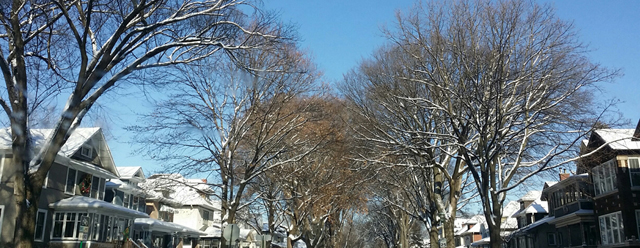By Cassandra West
When we think about nature in winter, we may think about snow, ice and gray skies. We may think about squirrels, and maybe cardinals. This is also the time of year when the graceful architecture of trees is starkly visible. Trees give us so many important gifts: cleaner air, fresh oxygen, stormwater management, shade, even energy efficiency for buildings. How well do you know the trees around you?
Next time you go outside, examine all the different types of bark textures and colors. Look at the branching structures. You may even see some flower and leaf buds on branches.
Connecting with and learning about the trees in our yards and community is so satisfying. Did you know that many tree experts think that winter can be one of the easiest times of year to identify trees? You can find tree ID guides at the library or online. Chicago and its inner-ring suburbs like Oak Park and River Forest are graced with many types of trees to enjoy and learn about.
Home to 18,000 trees and more than 150 species, Oak Park has the “tree cred” to be declared an arboretum. It’s hoping to add that designation this year. To move Oak Park forward as an arboretum, Park District and Village boards will develop an Intergovernmental Agreement that addresses various details: completing the application, data sharing, governing structure, management duties and collaboration with various local organizations (Openlands, Wild Ones, the OPRF Garden Club, The Learning Gardens and Green Community Connections).
The Lisle-based Morton Register of Arboreta, or ArbNet, will review the village’s application and grant accreditation, if all goes accordingly. An accreditation would make Oak Park only the second municipal arboretum in the United States. Bexley, a city of 13,000 in Ohio, became the first in 2013.
Arboreta become accredited by evaluating and submitting documentation on the level of achievement of specified standards, according to ArbNet, which maintains a comprehensive list and database of international arboreta and public gardens. ArbNet has established four levels of accreditation. Oak Park would qualify for Level II accreditation — a minimum number of 100 kinds (species or varieties) of trees or woody plants.
To get an accurate count, St. Charles-based Graf Tree Care is working on an updated village tree inventory, to be completed by the end of March. There are plenty of oaks — from which the village gets its name — along with lindens, ginkgos, sycamores, buckeyes, hackberries, maples and more. The arboretum status will cover only public trees, the ones in parks and parkways, but some local tree fans would like to let homeowners’ front yard trees be included as part of the inventory.
The group that initiated the effort to seek arboretum status hopes an official announcement could come by Arbor Day, says Oak Parker Kathryn Jonas, an arborist and Openlands-designated Treekeeper who is interested in making sure Oak Park maintains “a good, healthy urban forest.”


